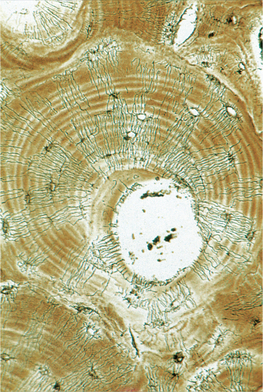H
H chemical symbol, hydrogen;; Hounsfield unit.
h symbol, hecto-; [L.] hora (hour).
H & E hematoxylin and eosin (stain).
H-2 complex the major histocompatibility complex in the mouse.
H band a zone across the center of the sarcomeres of skeletal muscle cells.
H2-receptor see histamine receptor.
HA used for hemagglutinin, hemagglutination, and hemagglutination assay.
HA-MRSA healthcare-associated methicillin-resistant Staphylococcus aureus.
HABA 2-(4’-hydroxyazobenzene) benzoic acid.
habena [h -be′n
-be′n ] the peduncle of the pineal body.
] the peduncle of the pineal body.
habitat [hab′ -tat] the environment inhabited by a specific organism or animal.
-tat] the environment inhabited by a specific organism or animal.
habitus [hab′ -t
-t s] [L.] habit, body conformation.
s] [L.] habit, body conformation.
Habronema [hab″ro-ne′m ] a genus of nematodes in the order Spirurida.
] a genus of nematodes in the order Spirurida.
H. khalili found in the large intestine of elephant and rhinoceros.
H. majus (syn. H. microstoma), H. muscae parasites in the stomach of horses.
H. megastoma Draschia megastoma.
H. microstoma see H. majus (above).
HACCP hazard analysis critical control points.
hachement [Fr.] a hacking or chopping movement in massage.
hackamore a single-rein bitless bridle for a horse.
H. pony small version of the Hackney.
Hadenvirus see bovine parvovirus.
haem- for words beginning thus see also those beginning hem-.
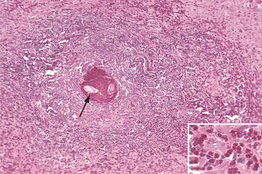
H-1: Sections of Habronema larvae (arrow) within nodule of granulomatous and eosinophilic dermatitis.
From McGavin MD, Zachary J, Pathologic Basis of Veterinary Disease, 4th Edition. Mosby, 2006.
Haemaphysalis [he″m -fis′
-fis′ -lis] a large genus of small ticks in the family Ixodidae.
-lis] a large genus of small ticks in the family Ixodidae.
H. bancrofti found on cattle and marsupials. Called also wallaby tick.
H. chordeilis (syn. H. cinnabarina, H. punctata) found on birds.
H. humerosa transmits Coxiella burnetti, the cause of Q fever.
H. leachi mushami occurs on small carnivores.
H. otophila found on rodents. May transmit Francisella tularensis.
H. parmata found on carnivores and antelope.
H. punctata see H. cinnabarina punctata (above).
H. atripalpis a vector for Parafilaria bovicola.
H. stimulans a pest of cattle.
H. elephantis found on elephants.
H. hopkinsi found on wart hogs.
Haematopinus [he″m -to-pi′n
-to-pi′n s] a genus of sucking lice in the order Phthiraptera.
s] a genus of sucking lice in the order Phthiraptera.
H. eurysternus found on cattle. Called also shortnosed cattle lice.
H. quadripertusus found on cattle.
H. tuberculatus found on cattle, camel, yak and buffalo.
H. indora a serious parasite of domestic poultry in Central America.
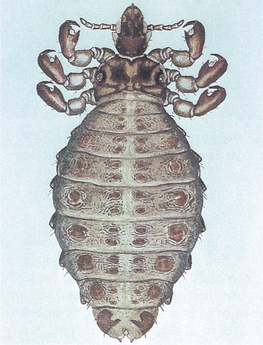
H-2: Haematopinus asini.
From Pascoe R, Knottenbelt DC, Manual of Equine Dermatology. Saunders, 1999
H. nodorus the most important species of bird bugs; infests poultry, turkeys and some wild birds.
Haematoxenus a genus of nonpathogenic protozoan parasites in the family Theileriidae.
H. separatus found in sheep. Transmitted by Rhipicephalus evertsi.
H. veliferus found in the bloodstream of cattle. Transmitted by Amblyomma variegatum.
haemo- word element. [Gr.] blood. See words beginning hem- and hemato-.
Haemodipsus [he″mo-dip′s s] a genus of lice in the family Hoplopleuridae.
s] a genus of lice in the family Hoplopleuridae.
H. ventricosus found on field rabbits; uncommon in laboratory animals.
Haemogamasus a genus of mites in the family Gamasidae.
H. pontiger found in bedding and on rodents and insectivorous animals.
H. sachae participates in the production of a leech-vectortransmitted lymphoma in cultured turbot.
Haemolaelaps a genus of mites of the family Gamasidae.
H. casalis a mite infesting birds and their litter.
Haemonchus [he-mon′k s] a genus of blood-feeding nematodes of the family Trichostrongylidae.
s] a genus of blood-feeding nematodes of the family Trichostrongylidae.
H. bedfordi found in African buffalo and some gazelles.
H. longistipes found in camel, dromedary.
H. mitchelli found in gazelle, eland, oryx.
H. placei the parasite of cattle which can cause haemonchosis in that species.
H. similis found in cattle and deer.
H. vegliai found in oryx, antelope.
Haemophilus [he-mof′ -l
-l s] a genus of hemophilic gram-negative coccobacilli or rod-shaped bacteria.
s] a genus of hemophilic gram-negative coccobacilli or rod-shaped bacteria.
H. agni (H. somnus); now called Histophilus somni.
H. avium now called Avibacterium avium.
H. equigenitalis see Taylorella equigenitalis.
H. gallinarum now classified as Avibacterium paragallinarum.
H. influenzaemurium the cause of respiratory disease and conjunctivitis in mice.
H. ovis now called Histophilus somni.
H. paracuniculus may be associated with mucoid enteropathy in rabbits.
H. paragallinarum now called Avibacterium paragallinarum.
H. somnus now called Histophilus somni.
H. suis now classified as H. parasuis (above).
H. canachites found in grouse; transmitted by Culicoides spp.
H. danilewski found in wild birds.
H. lophortyx found in quail. Transmitted by biting flies. May cause anemia.
H. meleagridis occurs in turkeys.
H. nettionis found in ducks, geese, swans.
H. sacharovi found in doves. Culicoides spp. possibly vectors.
Haflinger horse chestnut, light mane and tail, riding and draft pony from Austria, Germany, Italy.
hafnium (Hf) [haf′ne- m] a chemical element, atomic number 72, atomic weight 178.49. See Table 4.
m] a chemical element, atomic number 72, atomic weight 178.49. See Table 4.
Hagedorn’s needle [hah′g -dorn] see Hagedorn’s needle.
-dorn] see Hagedorn’s needle.
H. f. deficiency see Hageman trait.
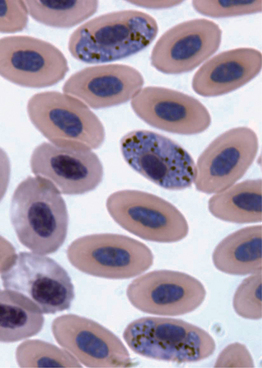
H-4: Haemoproteus spp. in avian red blood cells.
From Bowman, Dwight D. Georgis’ Parasitology for Veterinarians, 9th Edition. Saunders, 2008
hahnium (Ha) a chemical element, atomic number 105, atomic weight 260. See Table 4.
auditory h’s hair-like attachments of the epithelial cells of the inner ear.
awn h. in cats, a short thick, bristly hair underneath the top coat.
burrowing h. one that grows horizontally in the skin.
cover h. see guard hair (below).
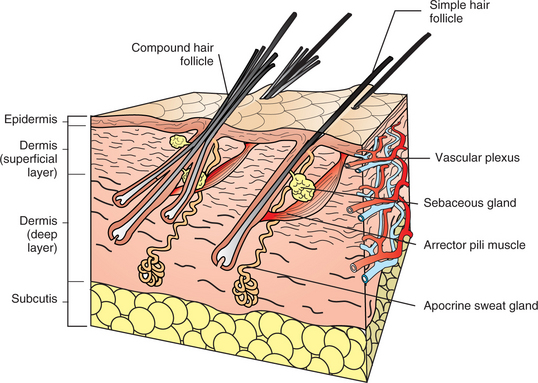
H-6: Schematic diagram of the skin and simple and compound hair follicles.
From McGavin MD, Zachary J, Pathologic Basis of Veterinary Disease, 4th Edition. Mosby, 2006.
h. follicle unit see apopilosebaceous complex.
h. granuloma granuloma in the esophageal wall caused by swallowed hairs acting as foreign bodies.
ingrown h. one that has curved and re-entered the skin.
lanugo h. the fine hair on the body of the fetus.
master h. see guard hair (above).
primary h. see guard hair (above).
sensory h’s hair-like projections on the surface of sensory epithelial cells.
specialized h. includes auditory, guard, sensory, tactile, taste, tylotrich hairs (see this list).
tactile h’s hairs particularly sensitive to touch.
tipped h. one with a different, usually darker, color at the tip; seen in Chinchilla cats.
hairball [hār′bawl] see trichobezoar.
hairlessness see alopecia, hypotrichosis, semihairlessness.
hairworms [hār′w rm] see Capillaria.
rm] see Capillaria.
hairy shakers [hār′e] see border disease.
Hairy moustached collie see Bearded collie.
Hajek rongeur a double action instrument used in neurosurgery.
Halal slaughter see Muslim slaughter.
halcinonide [hal-sin′ -nīd] a topical corticosteroid used in the treatment of skin diseases.
-nīd] a topical corticosteroid used in the treatment of skin diseases.
Halerpestis cymbalaria Ranunculus cymbalaria.
half-pin splint see half-pin splint.
Haliaeeatus leucocephala bald eagle.
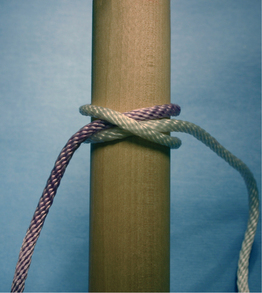
H-7: Double half-hitch (clove hitch).
From Sheldon CC, et al, Animal Restraint for Veterinary Professionals. Mosby, 2006
halide [hal′īd] a compound of a halogen with an element or radical.
Haliotrema a genus of flukes (monogenetic trematodes) parasitic on fish.
halisteresis [h -lis″t
-lis″t -re′sis] deficiency of mineral salts (calcium) in a part, as in osteomalacia.
-re′sis] deficiency of mineral salts (calcium) in a part, as in osteomalacia.
halitosis [hal″ -to′sis] offensive odor of the breath.
-to′sis] offensive odor of the breath.
Halobacterium [hal″o bak-tēr′e- m] obligate halophiles which spoil meat of high salt content.
m] obligate halophiles which spoil meat of high salt content.
halogenated pertaining to a substance to which a halogen is added.
h. salicylanilides. see rafoxanide, clioxanide.
halogeton [hal- -ge′t
-ge′t n] Halogeton glomeratus.
n] Halogeton glomeratus.
halophil, halophile [hal′o-fil] a halophilic microorganism.
haloprogin [hal″o-pro′jin] a synthetic broad-spectrum topical antifungal.
Haloragis a genus of shrubs in the family Haloragidaceae.
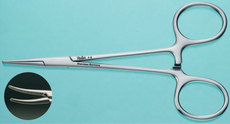
H-8: Halstead mosquito forceps.
From Sonsthagen TF, Veterinary Instruments and Equipment: A Pocket Guide, 2nd Edition. Mosby, 2010
Halsted [hal′sted] pertaining to William Halsted (1852–1922), an American surgeon.
H. mosquito forceps popular, fine-pointed, ratcheted hemostats used to crush very small vessels.
h. classes show classes in which entrant horses are required only to be halter broken.
haltere knob-like relics of the second pair of wings in the insect genus Diptera.
h. beetle the 0.5 inch long larvae of the beetle which infest hams. Called also Dermestes lardarius.
York h. a special curing method based on a pickle injection followed by a long storage in dry salt.
Hamadan ass a white, Iranian donkey.
hamamelis [ham″ -me′lis] see witch hazel.
-me′lis] see witch hazel.
hamartia [ham-ahr′sh ] a defect of tissue combination in development.
] a defect of tissue combination in development.
hamartoblastoma [ham-ahr″to-blas-to′m ] a tumor developing from a hamartoma.
] a tumor developing from a hamartoma.
lymphangiomatous h. a lymphangioma occurring as a congenital malformation.
vascular h. tumor mass, usually dermal, consisting of primitive to well formed blood vessels.
hamate [ham′āt] 1. hooked. 2. the fourth carpal bone. Called also os hamatum, os carpale IV.
Hambletonian one of the very early and important sires in the Standardbred breed of racing horses.
hamburger beef see hamburger beef.
Hamburger shift see chloride shift.
Hamilton hound [ham′il-ton] see Hamiltonstovare.
hammer [ham′ r] the malleus, the largest of the three bones of the middle ear.
r] the malleus, the largest of the three bones of the middle ear.
hammerhead RNA structure a folding arrangement of RNA found in the RNA genomes of some viruses.
Hammondia a genus of protozoa in the family Eimeriidae.
H. heydorni found in dogs; the oocysts, shed in feces, are identical to those of Neospora caninum.
Hampshire a black pig with a white belt, originating in the USA.
hamulus [ham′u-l s] any hook-shaped process.
s] any hook-shaped process.
Han sheep prolific Chinese meat and carpetwool sheep; fat-tailed variants.
h. gallop a restrained gallop at less than top speed.
hand tie suture tie made manually rather than with instruments.
handled said of a horse that has been caught, led, groomed. See also gentle.
handpiece [hand′pēs] sheep shears.
hangnail [hang′nāl] excessive growth and cracking of the cuticle on the feet of elephants.
Hannemania chigger mites infesting amphibians, especially frogs. Cause red spots and vesicles.
Hantavirus [han′t -vi″r
-vi″r s] a genus in the family Bunyaviridae.
s] a genus in the family Bunyaviridae.
hao chen the characteristic fine-caliber acupuncture needle.
haploidy [hap′loi-de] the state of being haploid.
haplomycosis [hap″lo-mi-ko′sis] a fungal disease caused by Emmonsia.
Haplosporangium [hap″lo-spor-an′je- m] see Emmonsia.
m] see Emmonsia.
H. nelsoni cause of multinucleate sphere unknown (MSX) disease in the American oyster.
haptoglobulin [hap″to-glo′bin] haptoglobin.
haptor posterior disk of a monogenetic trematode.
hard heads see Rhaponticum repens.
hard udder see caprine arthritis–encephalitis.
hard x-rays X-rays of shorter wavelength.
hardener a substance used to harden the gelatin of the emulsion on an X-ray film.
Harder’s gland Harderian gland.
hardkeeper an animal that is difficult to fatten.
hardmouthed said of a horse that is hard to restrain with the average bit.
h. disease traumatic reticuloperitonitis.
harelip [hār′lip] congenitally cleft lip.
Hariana Indian gray-white shorthorn-type draft cattle.
harmaline [hahr′m -lēn] see harmine.
-lēn] see harmine.
harmonic mean see harmonic mean.
harmonic ultrasound see harmonic ultrasonography.
h. galls cutaneous plaques of fibrous tissue where harness rubs.
hart male deer at 5 years. Called also stag.
Hartenstein’s gland the popliteal lymph node, e.g. in the pig.
Hartertia a genus of nematodes of the family Spirocercidae.
Hassall’s corpuscles [has′ l] bodies of epithelial cells found in the medulla of the thymus.
l] bodies of epithelial cells found in the medulla of the thymus.
hassium (Hs) a chemical element, atomic number 108, atomic weight 277. See Table 4.
h. liquid the contents of unfertilized eggs. Used in petfood manufacture.
hatchling a baby bird from hatching to the time the eyes open. See also nestling.
haustra [haws′tr ] plural of haustrum.
] plural of haustrum.
haustration [haws-tra′sh n] the formation of a haustrum.
n] the formation of a haustrum.
hauteur machine-estimated mean fiber length in a top of wool; the basis for the pricing of tops.
Haverhill fever [ha′v r-il] Streptobacillus moniliformis.
r-il] Streptobacillus moniliformis.
haversian [ha-vur′zh n] named after the English physician and anatomist Clopton Havers (1650–1702).
n] named after the English physician and anatomist Clopton Havers (1650–1702).
< div class='tao-gold-member'>
 -ben′u-l
-ben′u-l ] pl. habenulae [L.] 1. any frenulum, especially one of a series of structures in the cochlea. 2. a triangular area in the dorsomedial aspect of the thalamus rostral to the pineal gland.
] pl. habenulae [L.] 1. any frenulum, especially one of a series of structures in the cochlea. 2. a triangular area in the dorsomedial aspect of the thalamus rostral to the pineal gland. -bich″u-a′sh
-bich″u-a′sh n] 1. the gradual adaptation to a stimulus or to the environment. 2. the extinction of a conditioned reflex by repetition of the conditioned stimulus; called also negative adaptation.
n] 1. the gradual adaptation to a stimulus or to the environment. 2. the extinction of a conditioned reflex by repetition of the conditioned stimulus; called also negative adaptation. -sis] a disease of horses caused by the nematodes Habronema muscae, H. majus (H. microstoma) and Draschia megastoma.
-sis] a disease of horses caused by the nematodes Habronema muscae, H. majus (H. microstoma) and Draschia megastoma. -dip′s
-dip′s ] a genus of leeches in the class Hirudinea. Small (1–1.5 inches), but heavy infestations can cause anemia.
] a genus of leeches in the class Hirudinea. Small (1–1.5 inches), but heavy infestations can cause anemia. -to′be-
-to′be- ] a genus of small, gray, blood-sucking flies. Called also Lyperosia spp., Haematobosca spp.
] a genus of small, gray, blood-sucking flies. Called also Lyperosia spp., Haematobosca spp. -top′
-top′ -t
-t ] large, blood-sucking flies predatory on vertebrates. A genus of the family Tabanidae. They are mechanical transmitters of anthrax, equine infectious anemia, anaplasmosis and Trypanosoma evansi. Cyclical transmitters of Trypanosoma theileri. Cause significant insect worry to horses. Includes H. pluvialis.
] large, blood-sucking flies predatory on vertebrates. A genus of the family Tabanidae. They are mechanical transmitters of anthrax, equine infectious anemia, anaplasmosis and Trypanosoma evansi. Cyclical transmitters of Trypanosoma theileri. Cause significant insect worry to horses. Includes H. pluvialis. -to-si′fon] a genus of blood-sucking, true bugs of the family Cimicidae which includes, for example, the bed bug of humans.
-to-si′fon] a genus of blood-sucking, true bugs of the family Cimicidae which includes, for example, the bed bug of humans. ] a group of bacteria that parasitize erythrocytes and are now recognized to be within the genus Mycoplasma. See Mycoplasma haemocanis, M. haemofelis, M. haemomuris, M. hematoparvum, M. haemominutum.
] a group of bacteria that parasitize erythrocytes and are now recognized to be within the genus Mycoplasma. See Mycoplasma haemocanis, M. haemofelis, M. haemomuris, M. hematoparvum, M. haemominutum. -ri′n
-ri′n ] a genus of hemoprotozoa, parasitic mainly in cold-blooded vertebrates, including reptiles and fish. Includes parasites that cause hepatic necrosis, castration and occlusion of the air bladder.
] a genus of hemoprotozoa, parasitic mainly in cold-blooded vertebrates, including reptiles and fish. Includes parasites that cause hepatic necrosis, castration and occlusion of the air bladder.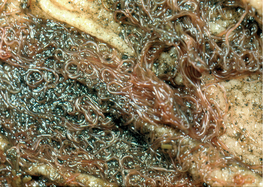
 s] a genus of protozoa that are parasitic in birds, reptiles and amphibians. Transmitted by insects, including mosquitoes and biting midges (Culicoides), when taking a blood meal. Infection is sometimes called pseudomalaria because of the parasite’s similarities with Plasmodium species.
s] a genus of protozoa that are parasitic in birds, reptiles and amphibians. Transmitted by insects, including mosquitoes and biting midges (Culicoides), when taking a blood meal. Infection is sometimes called pseudomalaria because of the parasite’s similarities with Plasmodium species. ] a genus of gram-negative, rod-shaped bacteria, members of the family, Enterobacteriaceae; found in soil and feces.
] a genus of gram-negative, rod-shaped bacteria, members of the family, Enterobacteriaceae; found in soil and feces.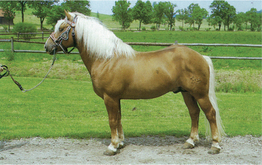
 -lo′bus] a free living rhabditid nematode; occasionally an accidental parrasite of horses and other animals. Enters the body via an existing lesion; infections in the brain are fatal.
-lo′bus] a free living rhabditid nematode; occasionally an accidental parrasite of horses and other animals. Enters the body via an existing lesion; infections in the brain are fatal. -loo′s
-loo′s -no-jen″] an agent capable of producing hallucinations or false sensory perceptions.
-no-jen″] an agent capable of producing hallucinations or false sensory perceptions. -j
-j n, ha’l
n, ha’l -j
-j n] an element of group VII of the periodic table, the members of which form similar (salt-like) compounds in combination with sodium. The halogens are bromine, chlorine, fluorine, iodine and astatine.
n] an element of group VII of the periodic table, the members of which form similar (salt-like) compounds in combination with sodium. The halogens are bromine, chlorine, fluorine, iodine and astatine. -na′sh
-na′sh n] the process of incorporating a halogen atom into an organic molecule. Halogenation of each double bond of an unsaturated fatty acid forms a basis for the measurement of a food’s content of unsaturated fatty acids.
n] the process of incorporating a halogen atom into an organic molecule. Halogenation of each double bond of an unsaturated fatty acid forms a basis for the measurement of a food’s content of unsaturated fatty acids. -dol] a dopamine antagonist in the brain, used as a neuroleptoanalgesic agent.
-dol] a dopamine antagonist in the brain, used as a neuroleptoanalgesic agent. ] a benign tumor-like nodule composed of an overgrowth of mature cells and tissues normally present in the affected part, but often with one element predominating.
] a benign tumor-like nodule composed of an overgrowth of mature cells and tissues normally present in the affected part, but often with one element predominating. -t
-t s] pertaining to a developmental anomaly in which certain cells of a circumscribed area develop excessively, but fail to keep growing as would a benign or malignant neoplasm.
s] pertaining to a developmental anomaly in which certain cells of a circumscribed area develop excessively, but fail to keep growing as would a benign or malignant neoplasm. r] small rodents in the subfamily Cricetinae; used as experimental laboratory animals but popular as pets. They are nocturnal, burrowing animals, noted for their brief gestation period (15–16 days) and capacious cheek pouches. Includes Cricetus cricetus (common or European hamster), C. griseus (Chinese hamster), Phodopus sungorus (Russian or short-tailed dwarf hamster) and Mesocricetus auratus (golden or Syrian hamster).
r] small rodents in the subfamily Cricetinae; used as experimental laboratory animals but popular as pets. They are nocturnal, burrowing animals, noted for their brief gestation period (15–16 days) and capacious cheek pouches. Includes Cricetus cricetus (common or European hamster), C. griseus (Chinese hamster), Phodopus sungorus (Russian or short-tailed dwarf hamster) and Mesocricetus auratus (golden or Syrian hamster).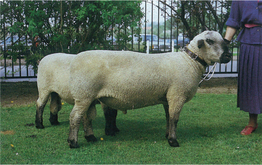
 l] the subjective sensation on palpating the fleece of sheep or alpacas; described by terms such as silky, soft, harsh, slippery.
l] the subjective sensation on palpating the fleece of sheep or alpacas; described by terms such as silky, soft, harsh, slippery. -te] the condition of having the same antigenic phenotype at certain specified loci; said of donor– recipient combinations in transplantation studies.
-te] the condition of having the same antigenic phenotype at certain specified loci; said of donor– recipient combinations in transplantation studies. s] a North American genus in the plant family Asteraceae (Compositae); plants contain a toxic alcohol, tremetol, and ingestion of the plant over a period causes a stiff gait, severe tremor and final collapse and death. Includes H. fruticosus, H. hartwegii, H. heterophyllus, H. tenuisectus. Called also Isocoma wrightii, Bigelowia rusbeyi, jimmy weed, rayless goldenrod, burrow weed. See also Eupatorium rugosum.
s] a North American genus in the plant family Asteraceae (Compositae); plants contain a toxic alcohol, tremetol, and ingestion of the plant over a period causes a stiff gait, severe tremor and final collapse and death. Includes H. fruticosus, H. hartwegii, H. heterophyllus, H. tenuisectus. Called also Isocoma wrightii, Bigelowia rusbeyi, jimmy weed, rayless goldenrod, burrow weed. See also Eupatorium rugosum. n] a small-molecular-weight either inorganic or organic molecule that alone is not antigenic but which when linked to a carrier protein, e.g. albumin, is antigenic; the antibody so produced will react with the hapten alone.
n] a small-molecular-weight either inorganic or organic molecule that alone is not antigenic but which when linked to a carrier protein, e.g. albumin, is antigenic; the antibody so produced will react with the hapten alone. r-e-
r-e- n gland] an accessory lacrimal gland deep in the medial orbit found n some terrestrial vertebrates; especially developed in rodents. The function is speculative but may include immunologic defense, photoprotection and pheromone production. Called also Harder’s gland. See also nasal dermatitis in gerbils.
n gland] an accessory lacrimal gland deep in the medial orbit found n some terrestrial vertebrates; especially developed in rodents. The function is speculative but may include immunologic defense, photoprotection and pheromone production. Called also Harder’s gland. See also nasal dermatitis in gerbils. rg] states that in an infinitely large, closed population, in which random mating occurs, both gene frequencies and genotype frequencies will remain constant.
rg] states that in an infinitely large, closed population, in which random mating occurs, both gene frequencies and genotype frequencies will remain constant. -kwin] 1. a coat color pattern that consists of irregular patches, usually gray, blue or black, on a white background. Common in Great Danes. 2. a breed of fancy rabbit with harlequin coat pattern in several colors.
-kwin] 1. a coat color pattern that consists of irregular patches, usually gray, blue or black, on a white background. Common in Great Danes. 2. a breed of fancy rabbit with harlequin coat pattern in several colors. n] a threaded metal rod used to connect distraction hooks in the stabilization of cervical vertebral instability.
n] a threaded metal rod used to connect distraction hooks in the stabilization of cervical vertebral instability. -s
-s n] a horizontal groove along the posterior border of the thorax corresponding to the costal insertion of the diaphragm; seen in rickets.
n] a horizontal groove along the posterior border of the thorax corresponding to the costal insertion of the diaphragm; seen in rickets. n-el′
n-el′ ] a protozoan parasite, free-living and thought not to be pathogenic, although they were at one time listed as being so.
] a protozoan parasite, free-living and thought not to be pathogenic, although they were at one time listed as being so. m] pl. haustra [L.] one of the pouches of the large intestine of horses, pigs and humans produced by the puckering action of the tenia coli and responsible for circular muscle fibers at 0.5–1 inch distances, and responsible for the sacculated appearance of the large intestines of horses and pigs. During activity of the large intestine the haustra appear and disappear with accompanying peristalsis.
m] pl. haustra [L.] one of the pouches of the large intestine of horses, pigs and humans produced by the puckering action of the tenia coli and responsible for circular muscle fibers at 0.5–1 inch distances, and responsible for the sacculated appearance of the large intestines of horses and pigs. During activity of the large intestine the haustra appear and disappear with accompanying peristalsis.